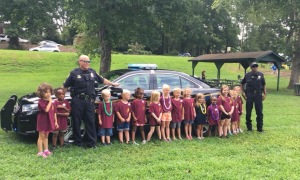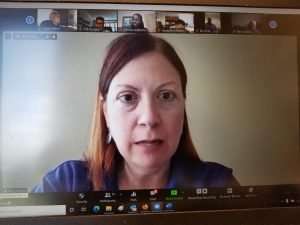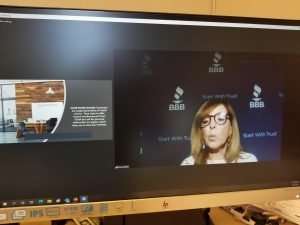
Aug 27, 2021 | Staying on Top, UpstateVibe365

Erin Ouzts, Upstate Entrepreneur Ecosystem Director
By Erin Ouzts, Upstate Entrepreneur Ecosystem Director
Being in the business of helping entrepreneurs start and grow their businesses, I often hear about the lack of awareness of the over 100 organizations that support entrepreneurs in the Upstate. Founders and business owners say they can’t find help to learn how to navigate the State or their local government’s procurement processes or how to set up Quickbooks or do market research.
Entrepreneur support organizations (ESOs) who work with entrepreneurs (this includes existing business owners), like the Small Business Development Centers, BGen, CommunityWorks, Village Launch and rural chambers of commerce say their biggest issue is creating awareness around the programs and services they provide.
The StartGrowUpstate.com website was built in spring of 2021 as “Your Connection to Business Resources in Upstate South Carolina” to create awareness for both the entrepreneurs and ESOs. It is formally called a resource navigator and allows visitors to search for the ESOs, resources and events in many ways.
As of mid-August, the StartGrowUpstate.com site provides information on many resources available to support entrepreneurs in the Upstate: 111 organizations; 263 programs provided by those organizations and 275 events on the calendar across the 10 counties. There are more organizations and programs waiting to be added, like the Studio Upstate, a student-run, faculty-led design firm that does most of the work of a traditional agency at a much lower price point, similar to the Clemson Student Consultant Center that supports entrepreneurs with market research, site selection, competitive analysis reports and other market research needs.
Visitors can search the site in many ways. On the homepage, start with the search bar right in the top section. Scroll down a little more and for Programs, People and Events. Scroll even further down for Featured Events and Deadlines.
From the top menu bar, the Explore button leads visitors to a section where they can search by Resource Type (Digital Tool, Media Source, Funding, Technical Assistance, Network, Showcase, Small Event, Talent Source, Registration, Educational Program, Space, and Competition); Stage (Idea, Early, Mature, Growth); Venture Type (Agricultural, Creative, Growth Startups, Retail or Main Street Stores, Product-Based, Service-based, Technology-based, Traditional, and Restaurants or Food Service); Who You Are (Founders of Color, Students, Underserved Founders); and Industry (Arts, Media and Entertainment; Community and Economic Development; Construction and Real Estate; Energy, Sustainability and Agriculture; Food, Drink and Hospitality; Government Defense and Aerospace; Industry Agnostic; Manufacturing and Advanced Materials; Retail, Product and Personal Services; Social Impact, Education, and Youth; Technology, IT, and Cybersecurity; Transportation, Wholesale, and Logistics).
The Programs section leads to thumbnail descriptions of all programs. Use Filters to narrow down the Programs listed. Visitors can filter by Resource Type, Stage of Business, Type of Business, Industry Group, Audience and Tags. After clicking on a program’s description, you will go to a more in-depth description, a button to visit that website and another thumbnail description of the hosting organization.
The Organizations button at the top of the homepage, leads visitors to thumbnail descriptions of people and organizations that can be filtered by What They do, Resources Provided, Ventures They Work With, Who They Serve, Organization Type and Area of Focus.
A fun feature of the Organizations are short video interviews with members of the organization that explain how they help entrepreneurs, in what type situations they are most helpful and when they will refer entrepreneurs to others. This allow visitors to “meet” the Upstate ESOs and determine if they are the best fit right away.
The Events button leads to a calendar of workshops and programs for entrepreneurs wanting to learn new skills to start and grow their businesses. Events range from the South Carolina Research Authority’s (SCRA) “Pathway to a Patent” series, to “Construction Contractor Opportunities with the Asheville Airport” by Hensel Phelps and Vannoy Construction, to “Everything You Need to Know about Google My Business” from SCORE and “Specialty Crop Resource Round-Up” by ACRE (Agribusiness Center for Research & Entrepreneurship).
No matter where an entrepreneur is on their journey, from idea to exit, StartGrowUpstate is the connecting point for business resources in the Upstate.

Aug 26, 2021 | Staying on Top
 Guest Speakers: Matt Bell from SCRA/SC Launch, Frannie Stockwell from the Cherokee County Chamber of Commerce, and Larry Bounds from Chautauqua Festival.
Guest Speakers: Matt Bell from SCRA/SC Launch, Frannie Stockwell from the Cherokee County Chamber of Commerce, and Larry Bounds from Chautauqua Festival.
Resource Updates
You can view a recording of the meeting here and the presentation here.
Frannie Stockwell, Cherokee Chamber of Commerce
- Cherokee’s Chamber works with existing businesses and brings in new businesses
- Economic Development finds industries and the chamber works with small businesses
- Connections are made other ways, such as TATT and Start-Grow Upstate
- SC Work Force assists with jobs and employees
- Institute of Innovation is a great resource for new businesses coming in (high school seniors graduate with a certificate)
- BGen is the Business Generator that assists with budget/vision/mission and helps get businesses on their feet in their space then graduates businesses out to their own space
- Know2 is a connector that also focuses on economic success
Larry Bounds, Chautauqua: History Comes Alive Festival
- Larry is a retired schoolteacher from Greenville County and has been involved for over 20 years in the Chautauqua History Comes Alive Festival
- Participants come from all over the country
- This festival honors historical characters such as Hetty Lamar, Rosa Parks, Benjamin Franklin
- At the Mauldin Cultural Center, the performance is outdoors with plenty of parking and space and in the case of weather they are presented virtually
- There are multiple shows per day from September 3-12
- Shows are free of charge (thanks to Metropolitan Arts Council and SC Humanities Commission and donations)
Learn more at http://historycomesalive.org/

Aug 26, 2021 | Uncategorized
 Creating a Safer Upstate: Workshop #1 – Use of Force
Creating a Safer Upstate: Workshop #1 – Use of Force
August 25, 2021
Recording of the Workshop
Panelists
- Chief Matt Hamby, City of Greer (Moderator)
- Chief Jim Stewart, Anderson Police Department
- Deputy Chief Jennifer Kindall, Spartanburg Police Department
- Chief Tony Taylor, Williamston Police Department
Welcome – Dean Hybl, Executive Director, Ten at the Top
TATT focuses on creating partnerships and collaborations around issues that impact economic vitality and quality of life in the ten-county region.
Over a year ago, we started conversations with law enforcement officials and residents to work collaboratively to ensure a safer Upstate. A discovery committee of about 50 people came up with recommendations, and under the guidance of Stan Davis, one of the important opportunities identified was to create dialogue to allay misconceptions and share law enforcement practices.
There will be four workshops in this Beyond the Shield series:
- Use of Force
- Technology – body cameras, car tag readers
- Hiring, Recruiting, Retention, and Training
- Neighborhood Safety Concerns
Chief Matt Hamby – Introduction
Why are we here? The aftermath of the George Floyd incident on Memorial Day 2020 shook our nation and created a nationwide conversation about policing.
Why do Law Enforcement Officers (LEOs) use force?
1. Protection of life:
- Protection of the life of a citizen, immediate jeopardy
- Protection of themselves
- This type of force can range from a very low amount of force – all the way up to, in rare instances, deadly force
2. Effect a legal arrest or detainment
- Enforce law
- Effect an arrest for a crime that was committed
- Effect a legal investigatory stop to investigate a crime in progress
Law Enforcement Use of Force is regulated by the 4th Amendment to the U.S. Constitution. The 4th Amendment provides that citizens are protected from unreasonable searches and seizures from the government (law enforcement)
- The 4th Amendment was written somewhat vaguely by the framers of our constitution, but that vagueness was intentional.
- Our Court systems, over time, have provided interpretations of the 4th Amendment as they issue decisions on appeals of court cases.
- Over time, two prevailing court cases have resulted in becoming the guiding principles for law enforcement’s use of force policies.
Tenn v. Garner
- A civil case in which the Supreme Court of the United States held that, under the Fourth Amendment, when a law enforcement officer is pursuing a fleeing suspect, the officer might not use deadly force to prevent escape unless “the officer has probable cause to believe that the suspect poses a significant threat of death or serious physical injury to the officer or others.
Graham v. Connor
- All Uses of Force in arrest and seizures of a citizen are judged by the 4th Amendment’s OBJECTIVE REASONABLENESS standard set by (Graham v Connor opinion in 1989). This OBJECTIVE REASONABLENESS standard analysis consists of:
- The severity of the suspected offense
- Did the suspect pose an immediate threat to the officers or others
- Is the suspect actively resisting or attempting to evade arrest by flight?
These two cases are the “meat and potatoes” of law enforcement policies as it refers to Use of Force.
Law Enforcement Agencies provide guidelines for their officers in the form of Policies and Procedures or General Orders.
These policies are available to the public to view.
The Greer Police Department’s entire General Order Manual is available online at the City of Greer website.
All LEOs are provided additional and continuous training systems at their own agency and by the SCCJA.
Chief Taylor – State Provided/Mandated Training (SCCJA)
- Appointed by Governor McMaster to be part of law enforcement training council
- Guides training for criminal justice academy and deals with certification issues
- In case of termination, when meeting certain criteria (for example, using excessive force, not being truthful in policy violations), officers can’t serve in SC and are entered into a national database
- Now requiring reserve officers in advance class 3 to take psychological testing (reserve officers work for free after passing test at academy)
- Duty to intervene – if an officer is not following proper protocol, it is up to other officer(s) to intervene and report to supervising officer
- Mental health is taken into account
- There is a mobile training team that will go to agencies and go through types of deadly force/critical skills sets.
Chief Stewart – Internal Agency Oversight of UOF
General Orders listed on City of Anderson website under About Us>General Orders
- Response to Resistance (formerly use of force) – changes highlighted in red, added new language, reviewed annually in training, and everyone signs off
- Duty to Intervene – spells out that everyone has the same responsibility as the officer.
- Recently completed defensive tactics training to go over fundamentals; firearms training, day and night qualifications, back-up ankle weapons, rifle, taser, baton, etc.
- Purchased TI training simulator
- Response to Resistance Form must be completed after every case
- All use of force incidents are listed on their website
- Mobile View and Smart Systems Body-Worn Camera (BWC) ability to capture picture for reports, night vision, capture audio
Deputy Chief Jennifer Kindall– Prevention/De-escalation Training
- Response to Resistance – mindset of officers, is key. You are responding to actions of the person you are dealing with
- Personnel must understand what constitutional authority they have in using force and training
- De-escalation is not a replacement for the use of force; it is a mindset that they hope to instill in officers that will aid and reduce the use of force
- Situations determine options available to officers
- We have a responsibility not to escalate situations and to reduce the intensity and slow things down to create an environment where the use of force is not necessary
- De-escalation has been in use for many, many years
- In Spartanburg, from January 1, 2019, to today, officers have responded to 135,665 calls for service. Out of those, 56 incidents of officers using force, which is less than 1%
- Weapon drawn is required data to ensure that officers are within policies
- Important to acknowledge mistakes when identified
- Work to be done on prevention and supplying information to national database.
Community Leader Q & A
- Reverend James C. Clark, Wilson Calvary Baptist Church
- Lamont Sullivan, Assistant Vice President for Advancement and Alumni Engagement at North Greenville University
- Dr. Jacqueline Blakley, Dean Public Services Division, Tri-County Technical College
Question: How is an officer to officer accountability assessed during situations where the use of force is used? For example, there were officers watching George Floyd during the whole time he was asking for help.
- Chief Taylor – Every agency should have a Duty to Intervene policy, confront other officer and intervene when the other office doing something unlawful.
Question: What is the desired outcome of the psychological testing? Does it give you insights to the natural aggression patterns of a potential officer candidate?
- Answer: In SC, every agency, when doing pre-hire background, must go through academy to see status. By law, if a person has been untruthful or has used excessive force, agencies must report misconduct and attend administrative hearing. Now able to fine agency that does not attend hearing.
Question: If senior officer arrives, how do junior officer know when to step aside?
- Answer: Every offer has the duty to intervene, and all personnel have a duty to report. Officers have affirmative duty to care for those in their custody.
Question: Is there a tracking mechanism for officers who profile?
- Answer: Any time officers stop a vehicle, by state law, they must complete a form that has gender, race, age, so it is trackable and commonly available on that agency’s website. Greer’s Public Contact Form is done electronically and available through the Public Safety website, search public contacts.
Question: How often is psychological testing done and what are they looking for?
- Answer: Psychological testing is required for the criminal justice academy. Most have early warning indicators, time out of work, excessive use of force, change in work performance. They may receive employee assistance through personnel. Issues could come from traumatic incidents.
We are looking for a psychological profile that is suitable for law enforcement and part of a comprehensive background investigation to confirm that the individual is a good fit for the profession and organization. SC mandates this as a requirement. It is important to trust the test.
From an academy perspective, evaluation content should cover developmental milestones, coping skills, management of financial responsibilities, freedom from any emotional issues, stress resilience, self-control, impulse control, etc. The list is extensive.
Wrap-Up
More workshops coming in the fall:
- Technology – body cameras, car tag readers
- Hiring, Recruiting, Retention and Training
- Neighborhood Safety Concerns
Dr. Blakley with Tri-County Technical College is working on in-person community and law enforcement engagement events. More information to follow.

Aug 25, 2021 | Staying on Top
 Connecting the Dots: 8/24/21
Connecting the Dots: 8/24/21
Click here to watch a recording of the workshop.
Panelists:
- Keith Scott from Electric City Transit
- Heather Lollis from CATbus
- Dan Hofmann from Clemson University
Introductions
Dan Hoffman from Clemson University
- Parking and transportation are under one roof at Clemson
- There are 14,000 parking spots
- Buses service campus and satellite locations
- There are many programs to reduce cars on campus
- Clemson has avoided $19M in parking expenses
Heather Lollis from CATbus
- CATbus connects Clemson with other cities and counties through partnerships with Electric City Transit, Greenville Transit Authority; Seneca, Central, Pendleton, Pickens, and Greenville
- Discussion is ongoing with GTA to develop consistent routes for Greenville to Clemson
- 2019 ridership numbers were used for FTA to determine how much grant funding, so low ridership will not affect funding
Keith Scott from Electric City Transit
- City of Anderson operates urban and rural service
- Partners with Anderson County on four urban routes
- Hours are Monday – Friday from 6:30 am-6:30 pm
- Started with three buses, now at six
- Routes go to both high schools, most medical facilities, many shopping areas.
- History with Duke Energy so funded with no taxpayer contribution
Connectivity
Keith Moody
- Anderson started with CATbus 2000-2001 with 4U Clemson, Southern Wesleyan, Anderson University, and Tri-County Tech to about 2011
- Anderson County used grant funding, and then fare was charged, but CATbus is not set up for fares. Routes were adjusted to connect in Pendleton instead of Anderson. This worked out well for Anderson folks because there are more connections. Riders enjoy going Clemson area, different restaurants, shopping, etc.
Dan Hoffman
- Clemson’s focus mainly on getting students to campus and reducing cars on campus
- Services also leave campus to go shopping and provide holiday airport shuttles.
- Transit funds come mainly from transit fees that students pay
- Other options include car-sharing, park, and ride for off-campus parking, bike share
- Meal plans subsidized for staff to reduce traffic in and out for lunch
- Most popular route is to Greenville
- Many faculty members use Tiger route that includes free public parking garage at CUICAR in Greenville.
- Gamification uses students and faculty tracking with prizes
- Most concerned about lack of bike infrastructure
- Conversations began with working with CATbus on data to increase good routes that are shorter.
- Running 15-minute service now.
- Lots of housing has been built within walking distance near downtown
Heather Lolis
- Seneca system first to be electric with 5-6 Proterra buses that have exceeded battery life expectations
- Bought 10 electric busses recently
- 100% electric is not possible due to emergency management protocols
Sense of Place – How to Incorporate Walking and Biking Safely
Dan Hoffman
- Clemson is very concerned about pedestrian safety.
- Studies have been done to mitigate risk with enhanced signaling and extra-large speed bumps.
- Working with Todd Steadmon and a committee working on enhancing bike safety
- Some apartments have created their own transit services
- Hybrid system in place with contractors, Cat bus, 25-30 buses of their own, and right-size fleet
- On football days, transit is all CATbus
Keith
- All buses have bike racks so that people may ride the many trails around city
- The city and county are in discussion about bike safety and infrastructure
- 50% of buses are natural gas and 50% diesel
- 2 new buses will be purchased this year
- Natural gas buses run in more condensed areas and diesel for longer routes for increased efficiency
- Natural Gas built filling station nearby
Looking Toward the Future
Heather
- Liberty, Easley, Powdersville need service and will be talking with Greenlink soon.
- Routes must run for three years before seeing ridership and receive grant funding.
- Walhalla would like service.
- Main focus is expanding and better connectivity with Greenville
- Extra bus shelters installed this year at busiest points
Routes to Major Employers
Keith
- Electric City goes to many major employers
- Expansion possibility to Highway 81 corridor
- Headways in Anderson are one hour, and 30-minute headways would double budget and number of drivers
- Budget would have to be increased with taxes in order to expand routes
Dan
- Creating convenience and options will be key
- Some things they are doing:
- Subsidized transit passes for employees
- Discounted park and ride lots
- Future might include:
- congestion pricing
- Expanding technology with real-time tracking of occupancy and timeliness
- Scooters (safely)
- Real-time parking sensors and availability
- Pilot program in student lot with 6 different permit types resulted in grant funding to expand bike share with electric bikes.
- DOE grant for autonomous vehicles to evaluate feasibility and safety
Watch for more information for Connecting the Dots event with Greenville and Spartanburg!

Aug 12, 2021 | Staying on Top
 Guest Speaker: Vee Daniel, Executive Director, Better Business Bureau of the Upstate
Guest Speaker: Vee Daniel, Executive Director, Better Business Bureau of the Upstate
You can view a recording of the meeting here and the presentation here.
Upstate Initiative Update
Dean Hybl, Executive Director, Ten at the Top
Resource Updates
 Amy Connor, New Horizon Family Health Services
Amy Connor, New Horizon Family Health Services
- New Horizon Family Health Services (NHFHS) is celebrating National Health Center Week to recognize the important work of health centers in improving the health of the communities we serve.
- Serving Greenville County since 1992.
- Medical offices in Greenville, Greer and Travelers Rest, a dental office in Greenville, a dental mobile unit and two mobile medical units.
- NHFHS accepts private insurance, Medicaid, Medicare and offers a sliding fee discount for uninsured individuals who qualify.
- Services include primary care, dental, behavioral health and onsite pharmacy and laboratory services.
- Ryan White Program provides medical and support services to individuals living with HIV/AIDS in a 10-county area of the Upstate.
- Health Care for the Homeless Program provides access to primary medical, dental, behavioral health and pharmacy services to individuals experiencing homelessness in a 13-county area using a traveling mobile medical unit at strategic partner locations.
https://tenatthetop.org/health-centers-remain-focused-on-health-care-access-during-pandemic/
 Trentsie Williams, GLEAMNS
Trentsie Williams, GLEAMNS
Oct 15th, 2021: Women’s Leadership Council Event: This is a great leadership opportunity put on by the Greenwood SC Chamber of Commerce. Sponsorship opportunities for companies, individuals. Great opportunity for mentors too! Click here to learn more!



 Guest Speakers: Matt Bell from SCRA/SC Launch, Frannie Stockwell from the Cherokee County Chamber of Commerce, and Larry Bounds from Chautauqua Festival.
Guest Speakers: Matt Bell from SCRA/SC Launch, Frannie Stockwell from the Cherokee County Chamber of Commerce, and Larry Bounds from Chautauqua Festival.
 Creating a Safer Upstate: Workshop #1 – Use of Force
Creating a Safer Upstate: Workshop #1 – Use of Force
 Connecting the Dots: 8/24/21
Connecting the Dots: 8/24/21

 Amy Connor,
Amy Connor,  Trentsie Williams, GLEAMNS
Trentsie Williams, GLEAMNS